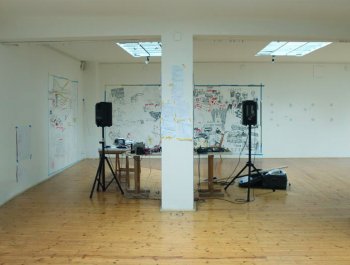kurátorka: Veronika Resslová
Během vernisáže performance Ewy Justky.
Zatímco v létě odjíždějí z nesnesitelně horkého města všichni na dovolenou, na festivaly nebo na venkov, nabízí opuštěná galerie příležitost k nerušenému soustředění.
O letošních prázdninách se ve Školské náhodně setkalo několik tematicky i mediálně odlišných projektů zahraničních umělců různých generací. Ewa Justka transformovala pomocí autorských elektronických nástrojů běžnými smysly nezachytitelné fyzikální jevy do zvukové podoby, Tamás Kaszás zkoumal v diorámatických instalacích ideologické pozadí modernistických architektonických forem, Péter Szabó pracoval na velkoformátové kreslené kronice „ dějin veřejných protestů “ současného Maďarska a Lloyd Dunn experimentoval s digitální syntézou stereoskopického obrazu z „found footage“ filmů ze třicátých let.
Výstava Mimo sezónu se snaží nemoderovaným způsobem přiblížit atmosféru nesourodého střetnutí jejich úvah.
Ewa Justka se dlouhodobě zabývá zvukovou materialitou objektů (elektronických obvodů, minerálů nebo částí rostlin a lidských těl), ze kterých sestavuje hudební elektronické nástroje a jejich fyzické vlastnosti pak zkoumá vytvářením okamžitých vzájemných interakcí v noiseových performancích a zvukových instalacích. Spleť elektronických nástrojů a jejich technických schémat, ještě nezpracovaných součástek a tematických knih a časopisů v instalaci je autorčiným přirozeným pracovním prostředím, hudební nástroje vzniklé během rezidence zpřístupňují sluchovému vnímání fyzikální jevy nesnadno zachytitelné běžnými smysly (například elektromagnetismus, elektrolýzu nebo oscilaci).
Péter Szabó během rezidenčního pobytu pokračoval v práci na dlouhodobém projektu „My Last Three Years“, který komentuje společenskopolitickou situaci současného Maďarska. Podkladem pro kreslenou kroniku veřejných protestů jsou digitální koláže z autorovy sbírky novinových fotografií. Velkoformátové kresby reflektují širokou škálu ekonomických, sociálních a politických otázek a mají být nakonec souborně vydány jako cenově dostupná publikace novinového formátu, která se bude prodávat ve veřejném prostoru.
Tamás Kaszás polemizuje s ideovým pozadím modernistických architektonických forem v diorámatických instalacích, tentokrát je podnětem z českého prostředí pražská Mullerova vila architekta Adolfa Loose v kontextu jeho známé stati Ornament a zločin. Systém prostorového uspořádání Mullerovy vily spočívá v narušení horizontální návaznosti jednotlivých pater (takzvaný Raumplan). Tento princip, který najdeme už ve starověkých a středověkých stavbách ale také - v kontrastu s Loosovým chápáním primitivních kultur jako zaostalých ve vývoji - připomíná typickou „spontánní architekturu“ zemí třetího světa, kde jsou architektonické bloky nebo chatrče živelně přistavovány jedna k druhé. Inspirován tímto rozporem realizoval autor dioramatický model improvizovaně postavených chatrčí v měřítku a uspořádání místností Mullerovy vily.
Druhý vystavovaný objekt představuje model Le Corbusierova Domino House (který byl Adolfem Loosem přímo ovlivněn) jako ruinu po civilizační katastrofě, naplněnou provizorně zbudovanými přístřešky a stany.
Lloyd Dunn se věnuje práci s nalezeným filmovým materiálem : vystavená práce „56911 play of light“ aplikuje stereografii na monooptické fragmenty abstraktního filmu László Moholy-Nagye „Ein Lichspiel : Schwarz Weiss Grau“ z roku 1930 a rekonstruuje tak částečně skutečný prostor, ve kterém byl film natočen. Přestože není možné vytvořit věrnou podobu toho, co nebylo ve skutečnosti nikdy zaznamenáno, je možné vdechnout plochým snímků filmu prostor, který je v nich latentně obsažen. Technika využívá pravidelný pohyb kamery nebo pravidelný pohyb objektu vzhledem ke kameře během záznamu scény v krátké sekvenci filmu pro vytvoření stereo párů sousedních monooptických záběrů a tím filmového stereogramu.
Ewa Justka, Tamás Kaszás a Péter Szabó jsou hostující umělci galerie v rámci programu Visegrád Artist Residency Program – Visual & Sound Arts, Lloyd Dunn je americký umělec dlouhodobě žijící v České republice.










